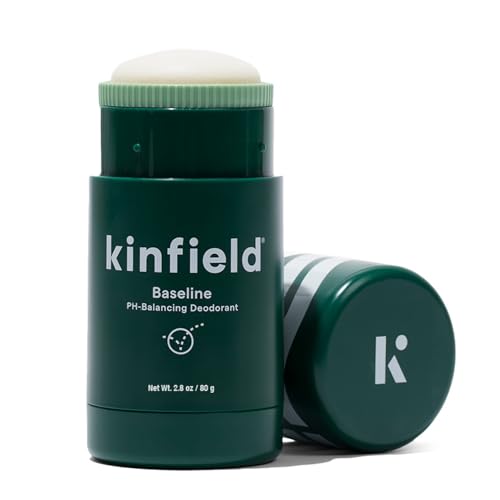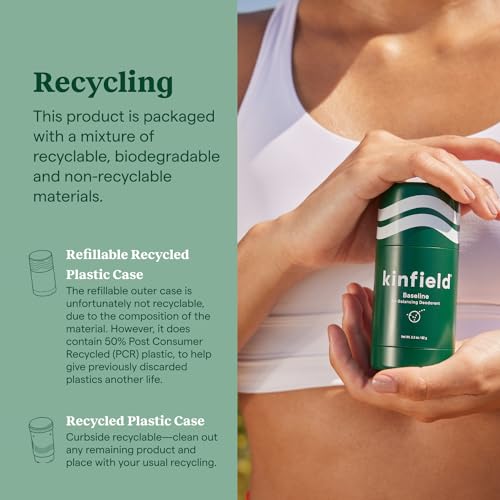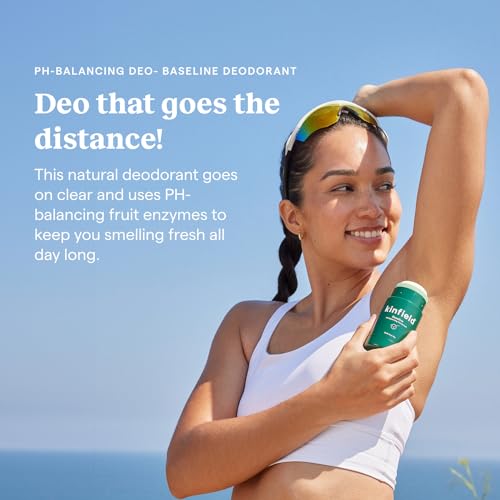




Kinfield Baseline Deodorant - PH-Balancing, Vegan, Refillable for Sensitive Skin - 2.8 oz


Jasminum Officinale (Jasmine) Oil
High RiskJasminum officinale (jasmine) oil is a volatile essential oil derived from the flowers of the jasmine plant. It is commonly used in cosmetics and personal care products for its fragrance and potential therapeutic properties.
Sustai Insights
Jasmine oil offers functional benefits such as providing a pleasant fragrance and potential skin-soothing properties. However, it has a high allergenic potential, posing risks of allergic reactions in sensitive individuals. While its carcinogenicity and developmental toxicity are low, regulatory bodies have placed some restrictions on its use due to these concerns. Overall, the risk level associated with jasmine oil is high, particularly in formulations where skin contact is frequent. Safe usage practices should be observed, and alternatives like synthetic fragrances could be considered.
Piroctone Olamine
High RiskPiroctone olamine is an amine salt commonly used in anti-dandruff shampoos and hair care products for its antifungal properties, particularly against Malassezia yeast, which is associated with dandruff and seborrheic dermatitis.
Sustai Insights
Piroctone olamine effectively combats dandruff due to its antifungal action, making it a valuable ingredient in hair care. However, it carries a high risk due to usage restrictions and potential health concerns, despite low levels of carcinogenicity, allergenic potential, and reproductive toxicity. Its environmental impact is unclear regarding bioaccumulation and ecotoxicity. Regulatory warnings highlight the need for careful adherence to guidelines. Overall, its risk level is high, and users should consider alternatives with better safety profiles.
Citrus Aurantium Dulcis (Orange) Peel Oil
Medium RiskCitrus aurantium dulcis (orange) peel oil is derived from the peel of oranges and is commonly used in cosmetic and personal care products for its fragrance and potential skin benefits. It is known for its aromatic properties and is often included in formulations aimed at enhancing scent profiles.
Sustai Insights
Citrus aurantium dulcis (orange) peel oil offers functional benefits such as providing a pleasant scent and potential antimicrobial properties. However, it poses a high allergy risk and may cause skin irritation in sensitive individuals. Environmental concerns include moderate persistence and potential to contribute to pollution. Regulatory warnings indicate restrictions on use in certain products. Overall, the risk level is assessed as medium, and users are advised to practice caution, particularly those with known allergies. Alternatives like sweet orange essential oil may provide similar benefits with potentially lower risks.
Helianthus Annus (Sunflower) Seed Wax
Low RiskHelianthus annuus (sunflower) seed wax is a naturally derived wax obtained from sunflower seeds, primarily used for its emollient properties in cosmetic formulations. It serves as a thickening agent, stabilizer, and moisture-retaining component, contributing to the texture and consistency of various products.
Sustai Insights
Sunflower seed wax offers functional benefits such as enhancing product texture and acting as a natural emulsifier. It is biodegradable and sourced sustainably, which aligns with eco-friendly practices. Health risks associated with this ingredient are low, with no significant concerns regarding carcinogenicity, allergies, or reproductive toxicity noted. Additionally, it does not pose environmental hazards, as it is not classified as a pollutant or bioaccumulative. Regulatory assessments indicate no current restrictions, resulting in an overall low risk level. Safe usage practices should be followed, and while alternatives exist, sunflower seed wax is a suitable option for many formulations.
Melaleuca Alternifolia (Tea Tree)
Low RiskMelaleuca alternifolia, commonly known as tea tree, is an unspecified preparation derived from the leaves of the tea tree. It is primarily used for its antiseptic properties and is found in various personal care products.
Sustai Insights
Tea tree oil offers functional benefits such as antimicrobial properties, making it effective in skincare formulations. It is considered to have low health risks, including low concerns for carcinogenicity, allergies, and reproductive toxicity. Environmental risks are minimal, with no significant pollutant or bioaccumulation potential. Regulatory bodies have noted no major advisories, and overall risk assessment remains low. For safe usage, it is recommended to use appropriate concentrations and consider alternatives like lavender or eucalyptus oil for similar benefits.
Vanilla Planifolia (Vanilla) Fruit Extract
Low RiskVanilla planifolia (vanilla) fruit extract is derived from the fruit of the vanilla plant. It is commonly used for its aromatic properties and as a flavoring agent in various products, including food, cosmetics, and personal care items.
Sustai Insights
Vanilla fruit extract offers functional benefits such as flavor enhancement and fragrance. It is sustainably sourced with low environmental impact and exhibits low risk for carcinogenicity and developmental toxicity. However, it may cause skin irritation in some individuals and has low to moderate allergenic potential. Regulatory bodies have not imposed significant restrictions, leading to an overall low risk assessment. Safe usage practices should be observed, and alternatives include synthetic vanillin for those seeking more stable options.
Simmondsia Chinensis (Jojoba)
Low RiskSimmondsia chinensis, commonly known as jojoba, is an oil derived from the seeds of the jojoba plant. It is commonly used in cosmetic formulations for its moisturizing properties, acting as an emollient and skin conditioning agent.
Sustai Insights
Jojoba oil offers functional benefits such as effective skin moisturization and is biodegradable, with sustainable sourcing practices. Health risks are low, with minimal concerns regarding carcinogenicity, allergies, and reproductive toxicity. Environmental impact is negligible, with no pollutant or bioaccumulation potential. Regulatory status is favorable with no significant restrictions noted. Overall, it is assessed as low risk, and safe usage practices should be maintained. Alternatives include other plant-derived oils like argan or almond oil, which may provide similar benefits.
Cedarwood Oil
Low RiskCedarwood oil is an essential oil derived from cedar trees, primarily used for its aromatic properties and as a natural ingredient in personal care products. It serves various functions, including acting as a fragrance, a potential preservative, and an insect repellent.
Sustai Insights
Cedarwood oil offers functional benefits, such as providing a pleasant scent and potential preservation properties due to its antimicrobial effects. It is sustainably sourced and biodegradable. Health-wise, it has low concerns regarding carcinogenicity, allergies, and reproductive toxicity. Environmentally, it poses low risks as a pollutant and is not bioaccumulative. Regulatory bodies have not issued significant warnings, confirming its low-risk status. Safe usage practices should be followed, and alternatives include plant-based essential oils with similar benefits. Overall, cedarwood oil is assessed with a low risk level.
Citrus Limon (Lemon) Peel
Low RiskCitrus limon (lemon) peel is derived from the outer skin of lemons and is commonly used in cosmetic formulations for its aromatic properties and potential skin benefits. It serves primarily as a fragrance agent and may also provide antioxidant effects.
Sustai Insights
Citrus limon (lemon) peel is valued for its aromatic contributions and potential antioxidant properties, which can enhance product appeal. It has a low risk of adverse health effects, including low concerns for carcinogenicity, allergies, and irritation. Environmental risks are minimal, with no significant evidence of bioaccumulation or pollution. Regulatory assessments indicate no restrictions on use. Overall, it is considered low risk, and safe usage practices should be maintained. Alternatives may include other citrus peels or natural fragrance compounds.
Caprylic Triglyceride
Low RiskCaprylic triglyceride is an ester derived from coconut oil and glycerin, commonly used in cosmetic formulations as an emollient, stabilizer, and skin-conditioning agent. It helps to improve the texture and spreadability of products while providing a lightweight, non-greasy feel.
Sustai Insights
Caprylic triglyceride offers functional benefits such as enhanced skin moisturization and improved formulation stability. It is generally regarded as safe, with low concerns regarding carcinogenicity, allergenic potential, and reproductive toxicity. Environmental impact is minimal, with no significant pollutant or bioaccumulative properties identified. Regulatory bodies have not issued warnings or restrictions. Overall, the risk level is low, making it a suitable ingredient in cosmetic products. Safe usage practices include adhering to recommended concentrations, and while there are alternatives, caprylic triglyceride remains a reliable choice.
Elettaria Cardamomum (Cardamom) Seed Oil
Low RiskElettaria cardamomum seed oil is a volatile oil extracted from the seeds of the cardamom plant. It is commonly used in cosmetic and personal care products for its aromatic properties and as a potential skin-conditioning agent. The oil serves various functions, including fragrance and flavoring in formulations.
Sustai Insights
Elettaria cardamomum seed oil offers functional benefits such as providing a pleasant aroma and potential skin-conditioning effects. It is considered to have low health risks, including low concerns for carcinogenicity, allergies, and reproductive toxicity. Environmentally, it does not significantly contribute to pollution or bioaccumulation. There are no specific regulatory warnings or restrictions associated with this ingredient. Overall, the risk level is assessed as low. Safe usage practices include avoiding excessive application, and alternatives such as other essential oils may be considered.
Zinc Ricinoleate
Low RiskZinc ricinoleate is a zinc salt of ricinoleic acid, primarily used in cosmetics for its properties as an odor-neutralizing agent. It functions by complexing with odor molecules, thereby reducing their volatility and effectiveness. This ingredient is often found in personal care products such as deodorants and body sprays.
Sustai Insights
Zinc ricinoleate provides effective odor control and can enhance product stability. It is derived from naturally occurring sources, contributing to its sustainability credentials. Health risks are low, with minimal concerns regarding carcinogenicity, allergies, or reproductive toxicity. However, it has moderate persistence and bioaccumulation potential. Regulatory bodies have not imposed significant restrictions, and common usage levels in products are deemed safe. Overall, the risk associated with zinc ricinoleate is low, making it a favorable choice in cosmetic formulations.
Citrus Aurantium Dulcis (Orange) Peel Oil
Medium RiskCitrus aurantium dulcis (orange) peel oil is derived from the peel of oranges and is commonly used in cosmetic and personal care products for its fragrance and potential skin benefits. It is known for its aromatic properties and is often included in formulations aimed at enhancing scent profiles.
Sustai Insights
Citrus aurantium dulcis (orange) peel oil offers functional benefits such as providing a pleasant scent and potential antimicrobial properties. However, it poses a high allergy risk and may cause skin irritation in sensitive individuals. Environmental concerns include moderate persistence and potential to contribute to pollution. Regulatory warnings indicate restrictions on use in certain products. Overall, the risk level is assessed as medium, and users are advised to practice caution, particularly those with known allergies. Alternatives like sweet orange essential oil may provide similar benefits with potentially lower risks.
Helianthus Annus (Sunflower) Seed Wax
Low RiskHelianthus annuus (sunflower) seed wax is a naturally derived wax obtained from sunflower seeds, primarily used for its emollient properties in cosmetic formulations. It serves as a thickening agent, stabilizer, and moisture-retaining component, contributing to the texture and consistency of various products.
Sustai Insights
Sunflower seed wax offers functional benefits such as enhancing product texture and acting as a natural emulsifier. It is biodegradable and sourced sustainably, which aligns with eco-friendly practices. Health risks associated with this ingredient are low, with no significant concerns regarding carcinogenicity, allergies, or reproductive toxicity noted. Additionally, it does not pose environmental hazards, as it is not classified as a pollutant or bioaccumulative. Regulatory assessments indicate no current restrictions, resulting in an overall low risk level. Safe usage practices should be followed, and while alternatives exist, sunflower seed wax is a suitable option for many formulations.
Melaleuca Alternifolia (Tea Tree)
Low RiskMelaleuca alternifolia, commonly known as tea tree, is an unspecified preparation derived from the leaves of the tea tree. It is primarily used for its antiseptic properties and is found in various personal care products.
Sustai Insights
Tea tree oil offers functional benefits such as antimicrobial properties, making it effective in skincare formulations. It is considered to have low health risks, including low concerns for carcinogenicity, allergies, and reproductive toxicity. Environmental risks are minimal, with no significant pollutant or bioaccumulation potential. Regulatory bodies have noted no major advisories, and overall risk assessment remains low. For safe usage, it is recommended to use appropriate concentrations and consider alternatives like lavender or eucalyptus oil for similar benefits.
Jasminum Officinale (Jasmine) Oil
High RiskJasminum officinale (jasmine) oil is a volatile essential oil derived from the flowers of the jasmine plant. It is commonly used in cosmetics and personal care products for its fragrance and potential therapeutic properties.
Sustai Insights
Jasmine oil offers functional benefits such as providing a pleasant fragrance and potential skin-soothing properties. However, it has a high allergenic potential, posing risks of allergic reactions in sensitive individuals. While its carcinogenicity and developmental toxicity are low, regulatory bodies have placed some restrictions on its use due to these concerns. Overall, the risk level associated with jasmine oil is high, particularly in formulations where skin contact is frequent. Safe usage practices should be observed, and alternatives like synthetic fragrances could be considered.
Vanilla Planifolia (Vanilla) Fruit Extract
Low RiskVanilla planifolia (vanilla) fruit extract is derived from the fruit of the vanilla plant. It is commonly used for its aromatic properties and as a flavoring agent in various products, including food, cosmetics, and personal care items.
Sustai Insights
Vanilla fruit extract offers functional benefits such as flavor enhancement and fragrance. It is sustainably sourced with low environmental impact and exhibits low risk for carcinogenicity and developmental toxicity. However, it may cause skin irritation in some individuals and has low to moderate allergenic potential. Regulatory bodies have not imposed significant restrictions, leading to an overall low risk assessment. Safe usage practices should be observed, and alternatives include synthetic vanillin for those seeking more stable options.
Simmondsia Chinensis (Jojoba)
Low RiskSimmondsia chinensis, commonly known as jojoba, is an oil derived from the seeds of the jojoba plant. It is commonly used in cosmetic formulations for its moisturizing properties, acting as an emollient and skin conditioning agent.
Sustai Insights
Jojoba oil offers functional benefits such as effective skin moisturization and is biodegradable, with sustainable sourcing practices. Health risks are low, with minimal concerns regarding carcinogenicity, allergies, and reproductive toxicity. Environmental impact is negligible, with no pollutant or bioaccumulation potential. Regulatory status is favorable with no significant restrictions noted. Overall, it is assessed as low risk, and safe usage practices should be maintained. Alternatives include other plant-derived oils like argan or almond oil, which may provide similar benefits.
Cedarwood Oil
Low RiskCedarwood oil is an essential oil derived from cedar trees, primarily used for its aromatic properties and as a natural ingredient in personal care products. It serves various functions, including acting as a fragrance, a potential preservative, and an insect repellent.
Sustai Insights
Cedarwood oil offers functional benefits, such as providing a pleasant scent and potential preservation properties due to its antimicrobial effects. It is sustainably sourced and biodegradable. Health-wise, it has low concerns regarding carcinogenicity, allergies, and reproductive toxicity. Environmentally, it poses low risks as a pollutant and is not bioaccumulative. Regulatory bodies have not issued significant warnings, confirming its low-risk status. Safe usage practices should be followed, and alternatives include plant-based essential oils with similar benefits. Overall, cedarwood oil is assessed with a low risk level.
Piroctone Olamine
High RiskPiroctone olamine is an amine salt commonly used in anti-dandruff shampoos and hair care products for its antifungal properties, particularly against Malassezia yeast, which is associated with dandruff and seborrheic dermatitis.
Sustai Insights
Piroctone olamine effectively combats dandruff due to its antifungal action, making it a valuable ingredient in hair care. However, it carries a high risk due to usage restrictions and potential health concerns, despite low levels of carcinogenicity, allergenic potential, and reproductive toxicity. Its environmental impact is unclear regarding bioaccumulation and ecotoxicity. Regulatory warnings highlight the need for careful adherence to guidelines. Overall, its risk level is high, and users should consider alternatives with better safety profiles.
Citrus Limon (Lemon) Peel
Low RiskCitrus limon (lemon) peel is derived from the outer skin of lemons and is commonly used in cosmetic formulations for its aromatic properties and potential skin benefits. It serves primarily as a fragrance agent and may also provide antioxidant effects.
Sustai Insights
Citrus limon (lemon) peel is valued for its aromatic contributions and potential antioxidant properties, which can enhance product appeal. It has a low risk of adverse health effects, including low concerns for carcinogenicity, allergies, and irritation. Environmental risks are minimal, with no significant evidence of bioaccumulation or pollution. Regulatory assessments indicate no restrictions on use. Overall, it is considered low risk, and safe usage practices should be maintained. Alternatives may include other citrus peels or natural fragrance compounds.
Caprylic Triglyceride
Low RiskCaprylic triglyceride is an ester derived from coconut oil and glycerin, commonly used in cosmetic formulations as an emollient, stabilizer, and skin-conditioning agent. It helps to improve the texture and spreadability of products while providing a lightweight, non-greasy feel.
Sustai Insights
Caprylic triglyceride offers functional benefits such as enhanced skin moisturization and improved formulation stability. It is generally regarded as safe, with low concerns regarding carcinogenicity, allergenic potential, and reproductive toxicity. Environmental impact is minimal, with no significant pollutant or bioaccumulative properties identified. Regulatory bodies have not issued warnings or restrictions. Overall, the risk level is low, making it a suitable ingredient in cosmetic products. Safe usage practices include adhering to recommended concentrations, and while there are alternatives, caprylic triglyceride remains a reliable choice.
Elettaria Cardamomum (Cardamom) Seed Oil
Low RiskElettaria cardamomum seed oil is a volatile oil extracted from the seeds of the cardamom plant. It is commonly used in cosmetic and personal care products for its aromatic properties and as a potential skin-conditioning agent. The oil serves various functions, including fragrance and flavoring in formulations.
Sustai Insights
Elettaria cardamomum seed oil offers functional benefits such as providing a pleasant aroma and potential skin-conditioning effects. It is considered to have low health risks, including low concerns for carcinogenicity, allergies, and reproductive toxicity. Environmentally, it does not significantly contribute to pollution or bioaccumulation. There are no specific regulatory warnings or restrictions associated with this ingredient. Overall, the risk level is assessed as low. Safe usage practices include avoiding excessive application, and alternatives such as other essential oils may be considered.
Zinc Ricinoleate
Low RiskZinc ricinoleate is a zinc salt of ricinoleic acid, primarily used in cosmetics for its properties as an odor-neutralizing agent. It functions by complexing with odor molecules, thereby reducing their volatility and effectiveness. This ingredient is often found in personal care products such as deodorants and body sprays.
Sustai Insights
Zinc ricinoleate provides effective odor control and can enhance product stability. It is derived from naturally occurring sources, contributing to its sustainability credentials. Health risks are low, with minimal concerns regarding carcinogenicity, allergies, or reproductive toxicity. However, it has moderate persistence and bioaccumulation potential. Regulatory bodies have not imposed significant restrictions, and common usage levels in products are deemed safe. Overall, the risk associated with zinc ricinoleate is low, making it a favorable choice in cosmetic formulations.
Discover the Kinfield Baseline PH-Balancing Deodorant, your go-to solution for natural, eco-friendly freshness. This vegan, refillable deodorant stick is formulated for sensitive skin, ensuring you stay fresh without harsh chemicals.
- Natural Sweat Control: Features arrowroot and fruit enzymes for effective odor removal without synthetic fragrances, perfect for sensitive skin.
- Light, Invigorating Scent: Enjoy the refreshing aroma of Lemon Verbena, Yuzu, and Ylang Ylang without white residue or stains.
- Sustainable Design: Made with 50% post-consumer recycled plastic, this eco-friendly stick promotes a cleaner planet while being gentle on skin.
- Travel-Friendly Size: Compact 2.8 oz design is ideal for on-the-go adventures, helping you feel fresh whether hiking or at the beach.
- Easy Application: Glide on a thin layer for best results; reapply as needed, and use compatible refills to minimize waste.
With Kinfield, embrace a product that aligns with your values, promoting health and sustainability while keeping you confidently fresh.
Subscribe & Save with Sustai
- Best Price Guarantee: Always enjoy the lowest prices on sustainable home essentials.
- No Surprises: We’ll notify you before shipping. No hidden fees, ever.
- You’re in Charge: Change, pause, or cancel your subscription anytime with ease.
- Eco-Friendly Deliveries: Our grouped shipments mean less packaging and lower emissions.
Join us on a sustainable journey. Special offers for a limited time! Prices and promotions may change.
Recommended Products
Discover the Kinfield Baseline PH-Balancing Deodorant, your go-to solution for natural, eco-friendly freshness. This vegan, refillable deodorant stick is formulated for sensitive skin, ensuring you stay fresh without harsh chemicals.
- Natural Sweat Control: Features arrowroot and fruit enzymes for effective odor removal without synthetic fragrances, perfect for sensitive skin.
- Light, Invigorating Scent: Enjoy the refreshing aroma of Lemon Verbena, Yuzu, and Ylang Ylang without white residue or stains.
- Sustainable Design: Made with 50% post-consumer recycled plastic, this eco-friendly stick promotes a cleaner planet while being gentle on skin.
- Travel-Friendly Size: Compact 2.8 oz design is ideal for on-the-go adventures, helping you feel fresh whether hiking or at the beach.
- Easy Application: Glide on a thin layer for best results; reapply as needed, and use compatible refills to minimize waste.
With Kinfield, embrace a product that aligns with your values, promoting health and sustainability while keeping you confidently fresh.

You can have at most 2 Sustainable Steals products in your cart
Customer Reviews
Customers’ View
Customers generally appreciate the effectiveness and eco-friendly nature of Kinfield's natural deodorant. Many users highlight the gentle formulation, noting it is aluminum-free and suitable for sensitive skin, with one customer stating, 'It went on easily and provided good coverage without being sticky.' The light, refreshing scent of Lemon Verbena and Yuzu has received positive feedback, with some referring to it as pleasant and not overpowering. Additionally, the product's refillable design is valued for reducing waste, although a few customers expressed concerns about the packaging and the need for the outer casing. Overall, users find this deodorant aligns well with their health-conscious and environmentally friendly values.
AI-generated from the text of customer reviewsThis product is rated 3.6 of 5.0 stars.
It has received 5 reviews.




